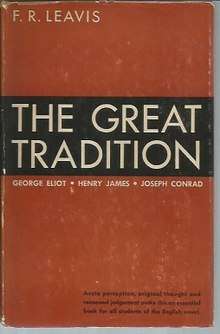The Great Tradition
The Great Tradition is a book of literary criticism written by F R Leavis, published in 1948 by Chatto & Windus.

(publ. George W. Stewart)
Highlights of the book
In his work, Leavis names Jane Austen, George Eliot, Henry James, and Joseph Conrad as the great English novelists. In all these eight, including Charles Dickens, Nathaniel Hawthorne, Herman Melville, and Edgar Allan Poe, we have successors of Shakespeare.[1]
Leavis disparaged Dickens except for his novel Hard Times, as lacking the "mature standards and interests" found in the works of Henry James. There was a similar contrast on the aspect of using melodrama in the novels, as compared to Joseph Conrad. In one statement on page 19, Leavis places Dickens among classic writers, but not in the great tradition: "That Dickens was a great genius and is permanently among the classics is certain. But the genius was that of a great entertainer, and he had for the most part no profounder responsibility as a creative artist than this description suggests."
Leavis held great sway over literary criticism of English literature until his death in 1978. Other views have emerged since then, in support of a greater number of authors.[2]
References
- Storer, Richard (2009). F.R. Leavis. Routledge. p. 71. ISBN 978-0-20301-535-3.
- McCrum, Robert (29 August 2016). "The 100 best nonfiction books: No 31 – The Great Tradition by FR Leavis (1948)". The Guardian. Retrieved 17 April 2019.
External links
- The Great Tradition at Archive.org
- "The Canon: The Great Tradition by F. R. Leavis". Times Higher Education. 14 May 2009. Retrieved 13 April 2013.